
Control Circuit
Index 4
American siren alarm circuit
Published:2014/1/24 20:22:00 Author:lynne | Keyword: American siren alarm circuit,
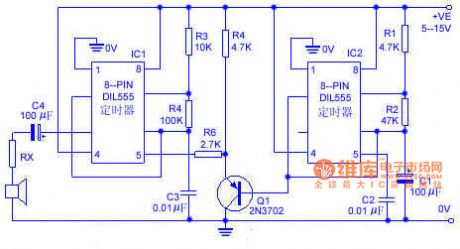
The circuit simulation an American siren sounds. IC2 is connected to a low-frequency multivibrator, the oscillation period is about 6s. C1 slowly changing ramp waveform applied to the PNP emitter follower Q1, and then applied to FM alarm generator IC1 through R6. IC1 natural center frequency of about 800Hz. Operation of the circuit is: alarm output signal from a low-frequency start, and then gradually rises to a high frequency within 3s, then dropped in the 3s to the original low frequency, and so forth continue. American siren alarm circuit shown in Figure:
(View)
View full Circuit Diagram | Comments | Reading(1352)
Dongfeng Peugeot Citroen Picasso 2.0L car door switch information circuit
Published:2014/1/23 20:29:00 Author:lynne | Keyword: Dongfeng Peugeot Citroen Picasso 2.0L car door switch information circuit,
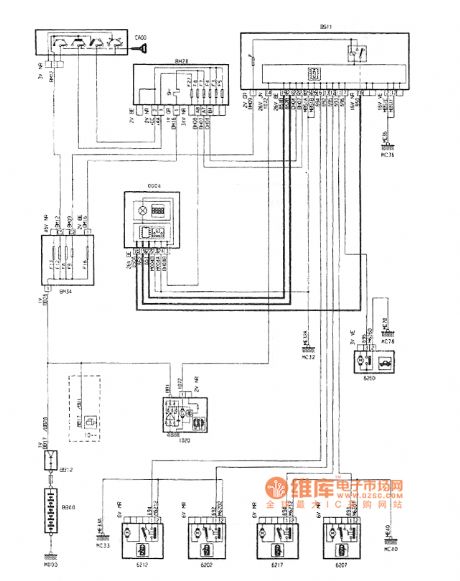
Dongfeng Peugeot Citroen Picasso 2.0L car door switch information circuit shown in Figure:
(View)
View full Circuit Diagram | Comments | Reading(1293)
Soft switching circuit schematic circuit diagram
Published:2014/1/21 21:10:00 Author:lynne | Keyword: Soft switching circuit schematic circuit diagram,

Soft switching circuit schematic circuit diagram shown in Fig.:
(View)
View full Circuit Diagram | Comments | Reading(1001)
Lu lian intelligent remote alarm system electric schematic diagram
Published:2014/1/19 21:52:00 Author:lynne | Keyword: Lu lian intelligent remote alarm system electric schematic diagram,
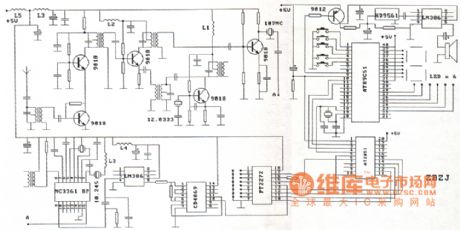
Lu lian intelligent remote alarm system electric schematic diagram as shown:
(View)
View full Circuit Diagram | Comments | Reading(1507)
Multi-channel burglar alarm circuit diagram
Published:2014/1/19 21:46:00 Author:lynne | Keyword: Multi-channel burglar alarm circuit diagram,
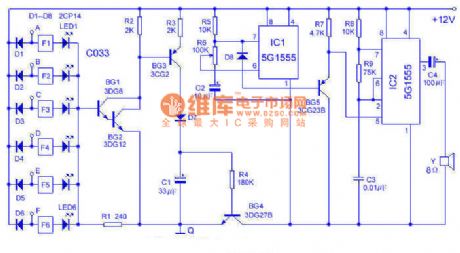
This alarm can be 6-way, from 0 to 30 km on the touch line in both sound and lighting for monitoring. Works in the following figure:Using 6 inverter C033 and light-emitting diodes (leds) as a touch alarm display. When the body contact (directly and/or wear gloves and indirect touch) when any one end in A ~ F, the end brings low potential, the inverter makes light-emitting tube LED display. At this moment, BG1 ~ BG4 conduction, C1 charging, acoustics part (IC1, IC2, etc.) begin to work. IC1, produce about 1 hz sawtooth wave by BG5 buffer to add to the IC2 modulation, IC1 oscillation frequency from low to high, the speaker sends out the similar public security police car alarm.
Use installation should pay attention to the Q end reliable to use A wire from the earth, A ~ F side respectively with bare copper wire to the surveillance, fixed place need porcelain insulation, at the same time pay attention to the rain, water, etc. Between cause and to form A low impedance. The alarm sensitivity is extremely high, standing on a chair touch wires can also call the police, the human body to leave after the all-clear to delay a few seconds. Power supply adopts 8 batteries. Adjust the R6 can change the tone. (View)
View full Circuit Diagram | Comments | Reading(1848)
Vibrating burglar alarm circuit
Published:2014/1/16 21:14:00 Author:lynne | Keyword: Vibrating burglar alarm circuit,
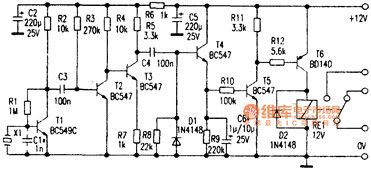
The alarms on the doors and windows using a hidden cheap piezo buzzer X1 as a sensor. This piezoelectric buzzer with bidirectional effect: when a voltage at both ends thereof, the piezoelectric ceramic material which will vibrate and produce a sound mechanical deformation; mechanical hand, when it is subjected to vibrations generated thief sound housebreaking When, at its ends will produce a corresponding output voltage.
>After the use of a property here, making it play a role in vibration sensor. As shown, the voltage generated by the piezoelectric sensor X1 transistor T1 of the first stage amplifier composed of the discharge is about 100 times. Effect transistor T2 from the detector, its collector voltage is only 50mv. Since R3 directly to the base of T2 being connected to the power line, T2 is always in the ON state can not afford to amplification. If you need to increase the magnification, you can change the upper end of R3 T2 collector received. The transistor T3 provides a voltage gain of about 3 times, and the drive pulse detector D1. When the input pulse level is high enough, T4 rapid charging to C6. After the pulse, C6 slow discharge through a high impedance circuit R9 and R10 and T5 base-emitter composed this discharge time determines the turn-on time of the relay. Therefore C6 capacity required by the test needs to decide its value can select between 1uF-10uF. Piezoelectric sensors X1 should use shielded cable to the input of the circuit Swiss, but the cable should be as short as possible. If radio frequency interference, as shown in dotted lines can be shown between the T1 connected to the base and to add a bypass RFI lnF ceramic capacitors. In use, a known vibration source (such as under normal environmental sounds produced) should be kept away from the sensor in order to avoid false triggering. When the relay is not working, the circuit consumes only a few milliamps. Vibrating burglar alarm circuit shown in Figure:
(View)
View full Circuit Diagram | Comments | Reading(947)
Train lights automatically switch circuit
Published:2014/1/12 21:37:00 Author:lynne | Keyword: Train lights automatically switch circuit,
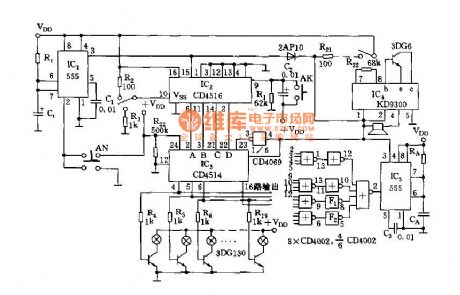
Train lights automatically switch circuit shown in Figure:
(View)
View full Circuit Diagram | Comments | Reading(756)
Household automatic water supply device circuit principle diagram
Published:2013/12/30 20:56:00 Author: | Keyword: Household automatic water supply device circuit principle diagram,
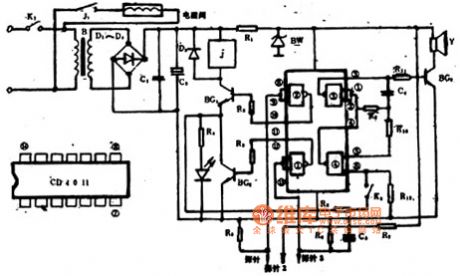
Household automatic water supply device circuit principle diagram
(View)
View full Circuit Diagram | Comments | Reading(1059)
The length of a probe based on circuit diagram of water vessel
Published:2013/12/30 20:44:00 Author: | Keyword: The length of a probe based on circuit diagram of water vessel,
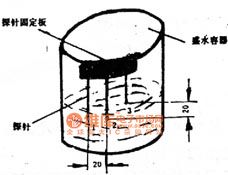
The length of a probe based on circuit diagram of water vessel
(View)
View full Circuit Diagram | Comments | Reading(716)
Household water supply printed circuit diagram
Published:2013/12/30 20:41:00 Author: | Keyword: Household water supply printed circuit diagram,
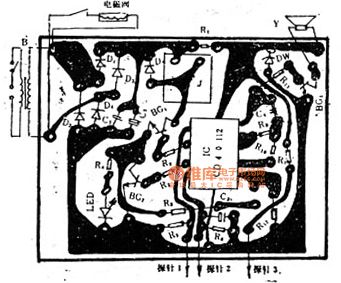
Household water supply printed circuit diagram
(View)
View full Circuit Diagram | Comments | Reading(750)
LDR PC Desk Lamp
Published:2013/12/3 20:40:00 Author:lynne | Keyword: LDR PC Desk Lamp
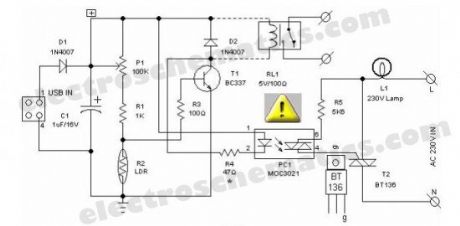
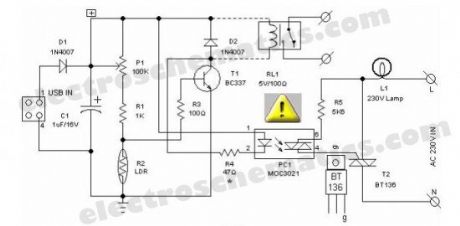
Most of the PC desk lamps available in the market light up whenever there is an input power. These don’t take into account whether there is a real need for the light or not. Here is an intelligent PC desk lamp circuit that overcome the problem.It senses the light level in the room to determine the actual need for light and lights up only if required. It is designed to work with the PC and remains on only when the PC in the table is in working state. It uses MOC3021.
Front end of the circuit is powered by the 5volt dc supply available from the usb port of the PC. When circuit is powered, the light sensor LDR (R2) resistance is low if there is sufficient light and thus most of the base current of transistor T1 finds an alternative easy path via LDR and T1 remains cutoff. While during dakness, the LDR behaves almost as an open circuit, and the current through sensitivity control preset pot (P1) and assosiated resistors (R1,R3) flows into the transistor’s base. As a consequence, T1 conducts to energise the opto-triac PC1. Next, the lamp driver triac T2 is fired through the opto-triac PC1 and switch on the power supply to the incandescent lamp.
The circuit can be constructed on a medium size PCB. After construction, enclose the finished circuit in a well insulated plastic cabinet. Then drill holes for mounting the ‘B’ type USB input socket, power switching termianls and the LDR etc. This circuit is meant for use in conjuction with Personal Computers to switch on an associated light sensitive table lamp/similar load. An optional electro magnetic relay can also be wired at the output of the circuit to switch heavy electrical load(s). For interconnection between PC and the control circuit, use a standard USB cable with an ‘A’ type connector on one end and a ‘B’ type connector at the other end.
LDR USB Desktop Lamp Circuit Schematic
(View)
View full Circuit Diagram | Comments | Reading(1036)
Light Alarm Circuit with LDR
Published:2013/12/2 21:09:00 Author:lynne | Keyword: Light Alarm Circuit

This musical light alarm circuit is very simple, uses only 7 components, a LDR and a 3.6 V battery or 3 x 1.2 volts rechargeable batteries. The well-known UM66 is used as the sound generator and will give a pleasent wake up alarm.
As you probably know the LDR is a light dependent resistor. Normally the resistance of an LDR is very high, sometimes as high as 1MΩ, but when they are illuminated with light resistance drops dramatically. In the circuit adjust the 220KΩ preset to the desired sensitivity, meaning adjusting the threshold point where the alarm start singing.
When there is light on the light dependent resistor the T1 transistor will start conducting and powers the UM66 musical integrated circuit. The produced musical note will be amplified by transistor T2 and fed into the 8Ω speaker.
On the UM66 IC are different numbers, each number giving a different musical note (in this example we use UM66T). You may use 2 x 1.5V batteries but 3 x 1.2V NiCad or NiMH are better because you can recharge them.
Light alarm electronic circuit schematic
(View)
View full Circuit Diagram | Comments | Reading(1133)
Low Current Relay Circuit
Published:2013/11/28 21:02:00 Author:lynne | Keyword: Low Current Relay Circuit
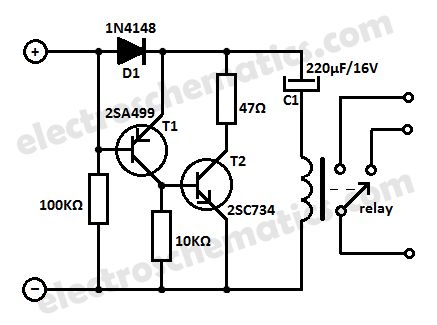
This low current relay circuit is designed to be used in battery operated electronic devices. Its operating current is in micro amperes (µA). This is done by using a bistable relay and adding some components to force the relay to behave like a monostable relay.
A bistable relay stays at its last state when the power is turned off but consume at least 50mA trigger current. A monostable relay switches back to its original state when the power is turned off.
How does the low current relay works?
When the power is turned ON, the C1 charges via D1 and the relay coil and this current activates the relay. D1 ensures that the base of T1 is always more positive than its emitter and because of this T1 and T2 are always blocked.
Once the power is turned OFF, the emitter of T1 is coupled to the charge voltage at the positive pole of C1. Its base and the relay coil on the other hand are coupled to the negative pole of C1 and now T1 and T2 conduct, C1 can discharge through T2 and relay. The current flows to the relay coil but in reverse order so is activated to its other state.
It has the advantage of consuming little current, around 150 µA. For a reliable operation, select the relay’s operating voltage as 2/3 to 3/4 of the main power supply. For example is using a 12V power supply select a 9V relay.
Transistors replacements:T1 = 2SA499 = BC557, BC558T2 = 2SC734 = BC547, BC548
Low current relay switch circuit schematic
(View)
View full Circuit Diagram | Comments | Reading(1311)
Universal Triac Control with Optocouplers
Published:2013/11/28 20:12:00 Author:lynne | Keyword: Universal Triac Control
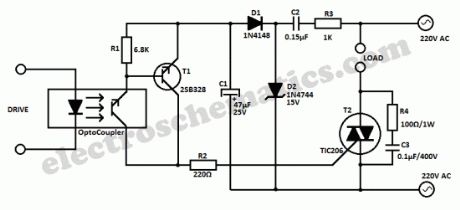
This universal triac controller circuit with optocoupler solves the problem that triacs have when functioning at low temperatures (triac needs higher gate current) by adding a transistor at the output of the optocoupler circuit.The transistor amplifiers the trigger pulse coming from the optocoupler and the gate current is high enough to trigger the triac in all temperature cases.
How does the circuits works?
The base of the transistor is driven by the OC. C2 works as capacitive bias resistance to avoid power losses and it also helps avoid DC loading of the supply line. The switch current is limited by R3. D1 works as one-way rectifier while C1 works as ripple filter.D2 stabilize the rectified voltage to 15 V.
T1 conducts when the OC sends a pulse to its base. C discharges through the collector-emitter line. The trigger current is limited by R2 to around 40 mA.The discharge current time of C1 is less than 1 ms.
The RC circuit R4 and C3 protects the triac from voltage spikes.This is very important in all inductive loads.
Triac Optocoupler Controller Schematic
(View)
View full Circuit Diagram | Comments | Reading(2021)
Universal Triac Control with Optocoupler
Published:2013/11/27 21:07:00 Author:lynne | Keyword: Universal Triac Control with Optocoupler
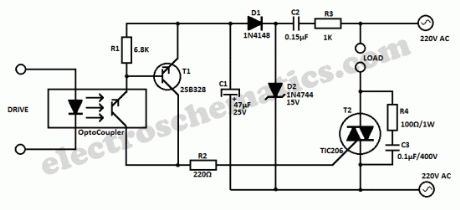
This universal triac controller circuit with optocoupler solves the problem that triacs have when functioning at low temperatures (triac needs higher gate current) by adding a transistor at the output of the optocoupler circuit.The transistor amplifiers the trigger pulse coming from the optocoupler and the gate current is high enough to trigger the triac in all temperature cases.
google_ad_client= ca-pub-9265205501290597 ;google_ad_slot= 6648404198 ;google_ad_width=336;google_ad_height=280;
How does the circuits works?
The base of the transistor is driven by the OC. C2 works as capacitive bias resistance to avoid power losses and it also helps avoid DC loading of the supply line. The switch current is limited by R3. D1 works as one-way rectifier while C1 works as ripple filter.D2 stabilize the rectified voltage to 15 V.
T1 conducts when the OC sends a pulse to its base. C discharges through the collector-emitter line. The trigger current is limited by R2 to around 40 mA.The discharge current time of C1 is less than 1 ms.
The RC circuit R4 and C3 protects the triac from voltage spikes.This is very important in all inductive loads.
Triac Optocoupler Controller Schematic
(View)
View full Circuit Diagram | Comments | Reading(2342)
220V Automatic Light Switch Circuit
Published:2013/11/25 20:24:00 Author:lynne | Keyword: Automatic Light Switch
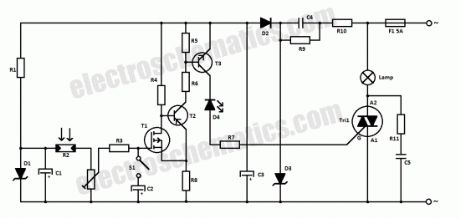
This light sensitive automatic light switch circuit is intended to be connected at the main 220V supply. The circuit will connect a 220V lamp at the nightfall and disconnects it in the morning light. The switching is made without a relay in order to avoid problems with the electric arc and noise caused by inductance coil and contacts.
The automatic light switch is powered from the 220V mains through R10, C4, D3, D2 and C3. A reference voltage source, D1, feeds with 8.2 V the circuit for measuring light, R2-P1. At lower light intensity, LDR’s resistance, R2, increases and therefore the P1 voltage falls, so will fall the gate-source voltage of FET’s T1.
When the switch S1 is closed, R3-C2 time constant makes that the gate voltage of T1 to vary slower then R2 resistance. This is necessary to prevent the circuit reaction at rapid changes of ambient light intensity.
Sensitive Automatic Light Switch Circuit Schematic
T1, T2, R4, R5, R6 and R8 forms a trigger Schmitt. Normally, T1 is open and T2 is blocked. When the gate voltage of the FET goes below a certain level, T2 starts to conduct and so does T2 which will provides the necessary gate current to boost the triac Tri1 in order to connect the load (220V lamp).
Components listR1 = 2.2KR2 = LDRR3 = 150KR4 = 15kR5 = 10kR6 = 27kR7 = 560ΩR8 = 1.2kR9 = 1.2MR10 = 470ΩR11 = 100ΩC1 = 4.7µF/16V tantalumC2 = 47µF/16VC3 = 1000µF/16VC4 = 470nF/250V~(630V)C5 = 100nF/630VD1 = 8.2V zenerD2 = 1N4001D3 = 15V/1W zenerD4 = LEDT1 = BS250T2 = BC557BT3 = BC547BTri1 = TIC226MF1 = 5A (View)
View full Circuit Diagram | Comments | Reading(1070)
Temperature Controlled Relay Circuits
Published:2013/11/24 20:56:00 Author:lynne | Keyword: Temperature Controlled Relay Circuits
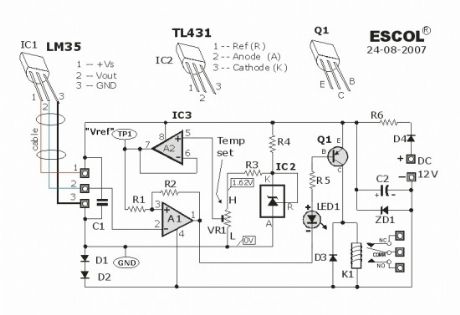
This temperature controlled relay circuit is a simple yet highly accurate thermal control circuit which can be used in applications where automatic temperature control is needed. The circuit switches a miniature relay ON or OFF according to the temperature detected by the single chip temperature sensor LM35DZ.
When the LM35DZ detects a temperature higher than the preset level (set by VR1), the relay is actuated. When the temperature falls below the preset temperature, relay is de-energized. The circuit can be powered by any DC 12V supply or battery (100mA min.)
Electronic Temperature-Controlled Relay Schematic
How it works?
The heart of the circuit is the LM35DZ temperature sensor which is factory-calibrated in the Celsius (or Centigrade) scale with a linear Degree->Volt conversion function. The output voltage (at pin 2) changes linearly with temperature from 0V (0oC) to 1000mV (100oC).
The preset (VR1) & resistor (R3) from a variable voltage divider which sets a reference voltage (Vref) form 0V ~ 1.62V. The op-amp (A2) buffers the reference voltage so as to avoid loading the divider network (VR1 & R3). The comparator (A1) compares the reference voltage Vref (set by VR1) with the output voltage of LM35DZ and decides whether to energize or de-energize the relay (LED1 ON or OFF respectively).
Components list:
IC1 : LM35DZIC2 : TL431IC3 : LM358
LED1 – 3mm or 5mm LED
Q1 – General purpose PNP transistor ( A1015,…) with E-C-B pin-out)D1, D2 — 1N4148D3, D4 — 1N400x (x=2,,,,.7)
ZD1 — Zener diode, 13V, 400mW
Preset (trim pot) : 2.2K (Temperature set point)R1 – 10KR2 – 4.7MR3 – 1.2KR4 – 1KR5 – 1KR6 – 33Ω
C1 – 0.1 µF ceramic or mylar capC2 – 470 µF or 680 µF electrolytic cap. (16V min)Miniature relay – DC12V DPDT, Coil = 400 Ω or higher (View)
View full Circuit Diagram | Comments | Reading(1472)
Automatic Light Switch with PhotoTransistor Circuit
Published:2013/11/14 19:36:00 Author:lynne | Keyword: Automatic Light Switch
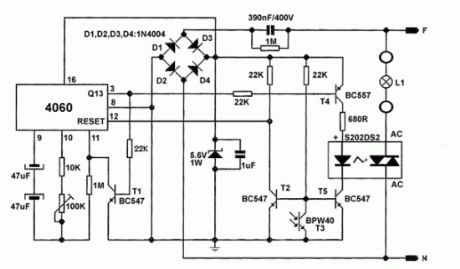
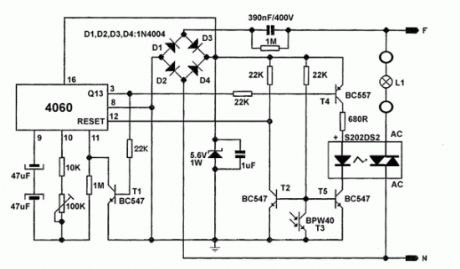
This is an automatic light switch circuit that turns ON a light bulb in absence of light. The IC 4060 works as an oscillator and generates a signal that is applied to the base of T4 transistor. Phototransistor T3 BPW40 is in conduction when light is present and it keeps the T5 transistor’s base at ground potential.When light goes out and it doesn’t reaches the phototransistor, it gets in insulation. T3 reaches positive potential through 22kohm. T4 and T5 both gets in conductance. The oscillator signal reaches the optic coupler and then turns on the lamp.
(View)
View full Circuit Diagram | Comments | Reading(1151)
Temperature Relay Circuits
Published:2013/11/11 19:18:00 Author:lynne | Keyword: Temperature Relay Circuit
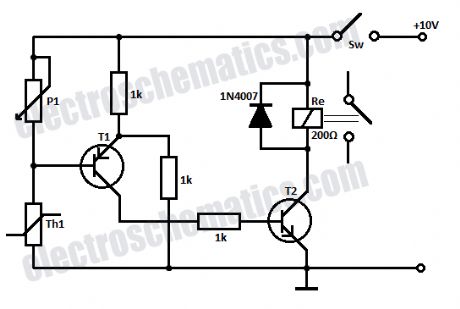
This simple temperature relay circuit can be used to signal a fire or setpoint for temperature monitoring function. You need to adjust P1 so that T1′s base voltage is 0.5V smaller than the emitter voltage at a temperature a little bit lower than the desired triggering (switching) temperature.If the temperature increases then T1 and T2 start conducting and the relay is closed (ON). If you want to use it as a cold relay or to signal an inferior temperature limit, then Th1 and P1 change places. After the relay is triggering you need to open switch S1 in order to stop the circuit. The nominal value of P1 must be choosed according to the used NTC thermistor and the switching temperature to be adjusted.
Temperature relay schematic
(View)
View full Circuit Diagram | Comments | Reading(1118)
12V SCR Battery Charger Circuits
Published:2013/11/10 20:09:00 Author:lynne | Keyword: SCR Battery Charger
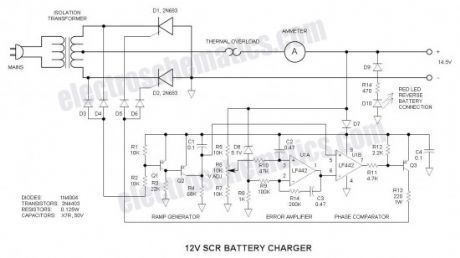
This battery charger circuit differs from the norm in a number of ways, all of which make it difficult to understand. For this reason, I do not recommend it for the beginner.
Repairing /revamping a dead chargerWhat I started with was an inoperative 12amp battery charger. In hope of repairing it, I traced out the circuit, but did not like what I found—poor circuit design. So what I had to start with was an enclosure, ammeter, thermal overload interrupter, and center-tapped transformer all designed for battery charger application.
Since the maximum current delivered by the unit is a function of the transformer internal impedance, I recommend that the readers use the same type of transformer. If you are a good pack-rat (like me), you may already have a dead charger—or you can be on the lookout for one.
12V Battery Charger Schematic
SCR (Thyristor) RectifiersFirst of all, the two SCRs (silicon controlled rectifiers or thyristors) are connected with their anodes (stud or tab) grounded—this makes for excellent thermal transfer because no insulating hardware is required (if it is permissible to connect the negative terminal of the charger directly to the steel enclosure). If you do not wish to ground this point, use insulating hardware to electrically isolate the SCRs. This makes the transformer center-tap the positive terminal. The reason for this circuit placement is the ease of driving the SCR gates via the positive battery voltage—it is very unconventional as I have never seen this trick done before.
SCRs are the ideal power device choice for a battery charger because they can both regulate battery charging voltage and prevent fault current when the battery is inadvertently connected reverse. I have actually connected mine reverse and thought that the charger was inoperative until I realized what I had done.
Power Device SelectionI used two 2N690 stud-mount SCRs that I had available. Any in the series will work (2N683 through 2N690)—only the voltage rating differs and anything greater than 100V is good for the application. Other more inexpensive TO-220 candidates are: STMicroelectronics TYN616, Teccor/Littlefuse S6015L (isolated package), NXP 151-500C, or ON Seimconductor 2N6403G. Avoid sensitive gate devices.
Circuit CommonNormally circuits use a negative common—that is just the way the world seems to work, but in this case, it was more convenient to make the positive rail the common point and all visualization must be made with this in mind. The only exception is D7 that was installed to prevent damage should the battery get connected reverse. For visualization, simply short out D7. The conventional ground symbol is used for the negative rail. This tends to tie your brain in knots…
Voltage ReferenceA good battery charger tapers off when the battery voltage is above about 14V. For this to function, D6 is a 5.1V shunt zener regulator that puts out -5.1V relative to the positive rail. It is biased via R8.
Ramp GeneratorC1 and R4 form a ramp generator that generates a negative going sawtooth voltage (relative to the positive rail). It is reset to the positive rail via Q1 and Q2 at line voltage zero crossing. At zero crossing, there is no voltage at the anodes of D3 & D4 (relative to the positive rail), Q1 is off, Q2 is on and C1 is shorted. At all other points in the AC line cycle, C1 is charging. My line frequency is 60HZ. For 50HZ, increase the value of R4 to 82K.
Error AmplifierU1A is the error amplifier—it amplifies the difference between the -5.1V reference voltage and the feedback voltage at the arm of the V ADJ pot (R6). It is slowed down by the RC filter (R10 & C2), proportionately amplified by the ratio of R14 /R9, and integrated via C3. Perhaps you have heard of a PID (proportional, integral, derivative) control—this does just that, but neglects the derivative term as it is generally not required in most applications. If the error amplifier is not satisfied, it continues to integrate its output voltage until the feedback voltage equals the reference voltage. The function of the operational amplifier is to make the two input voltages equal.
The device selection here is the LF442 (or TL082) J-FET input operational amplifier. This is vital in this circuit because the common mode voltage range of the differential inputs must extend to the positive rail. Few op amps can do this (many have differential voltages that extend to the negative rail, but those will not work in this application).
Phase ComparatorU1B is the phase comparator. It compares the ramp voltage with the output of the error amplifier. It is also called the ramp-intercept technique. When the ramp generator voltage exceeds the error voltage signal (in the negative direction), the output of U1B switches negative and turns on Q3 thus providing gate current to the SCR that is forward biased. R13 is the gate current limiting resistor.
Flashing a Dead BatteryThe battery provides the power to begin operation of the regulator circuit, so if the battery is fully discharged it may be necessary to “flash” the battery terminals with a good battery to bootstrap the regulator into operation.I have toyed with the idea of installing a “Flash” pushbutton, but this adds more circuitry and I have not found it necessary. (View)
View full Circuit Diagram | Comments | Reading(2316)
| Pages:4/312 1234567891011121314151617181920Under 20 |
Circuit Categories
power supply circuit
Amplifier Circuit
Basic Circuit
LED and Light Circuit
Sensor Circuit
Signal Processing
Electrical Equipment Circuit
Control Circuit
Remote Control Circuit
A/D-D/A Converter Circuit
Audio Circuit
Measuring and Test Circuit
Communication Circuit
Computer-Related Circuit
555 Circuit
Automotive Circuit
Repairing Circuit